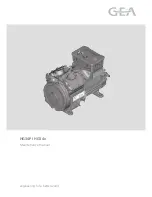
16
Troubleshooting continued
Problem
Possible cause
Suggested remedy
Insufficient pressure or decreased
outlet capacity continued
Air fittings leaking.
Check all air fittings. Make sure that
they are tight and not leaking at the
joins. If a quick release fitting is leaking,
disconnect it and reconnect it. If it
continues to leak replace the defective
fitting(s). If a male or female fitting
is leaking around the thread tighten
using a spanner. If the fitting is already
tight and can’t be tightened anymore
unscrew the connection, remove the
Teflon tape and look at the condition
of the fitting(s). If the a fitting(s) is
damaged replace and reassemble
using Teflon tape on threaded fittings.
If the fitting looks OK or reapply Teflon
tape and re assemble.
Maintenance
1. After each day of operation,
use the drain cock (13) under
the tank to drain out any
condensation (Fig. O).
2. After each day of operation
check daily the operation of
the safety valve (10). This
check should be performed
when the tank contains close
to max pressure.
To check the valve, pressurise the tank, and pull the
ring OUTWARDS on the safety valve.
Air should discharge from the valve.
Release the ring of the safety valve. When the ring is
released the air discharge must stop.
WARNINGS.
Safety glasses must be worn when performing this test.
Do not have your face close to the safety valve when
performing this test as air will discharge from the valve at a
high force.
If the safety valve does not operate correctly in any way as
described above, turn off the compressor immediately and
have the compressor and safety valve checked and tested
at an authorised Service centre.
DO NOT CONTINUE TO USE THE COMPRESSOR IN
ANY WAY IF THE SAFETY VALVE DOES NOT WORK
AS ABOVE.
General inspection
1. Regularly check that all the fixing screws are tight.
2. The supply cord of the tool should be checked frequently
for damage. If damaged, have the cordset replaced by an
authorised service facility to avoid a hazard.
O





































